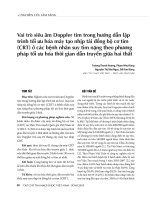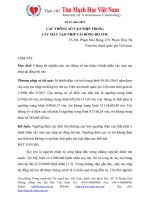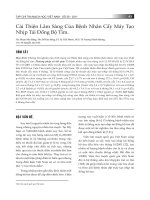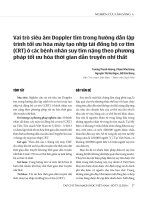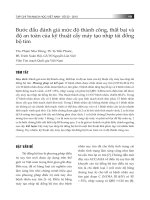Bài giảng Cập nhật trong tạo nhịp tái đồng bộ tim (CRT) - TS.BS. Trần Song Giang
Bạn đang xem bản rút gọn của tài liệu. Xem và tải ngay bản đầy đủ của tài liệu tại đây (2.63 MB, 31 trang )
HN TM Miền Trung mở rộng lần thứ X 07-2019
Cập nhật trong
Tạo nhịp tái đồng bộ tim (CRT)
TS.BS. Trần Song Giang
Viện Tim mạch Việt nam
Proprietary and confidential — do not distribute
NỘI DUNG
1. Chỉ định cấy CRT
2. Các tiến bộ trong tối ưu hóa CRT
Proprietary and confidential — do not distribute
2
Hiệu quả cấy CRT
Ở BN suy tim, EF giảm, có mất đồng bộ
So với điều trị Nội khoa, CRT với hiệu quả:
• Lâm sàng: Cải thiện mức độ NYHA, Test đi bộ (6 MWT results) và chất lượng
cuộc sống1
• Siêu âm tim: LVESV, LVEDV, LVEF…
• Giảm tỷ lệ tái nhập viên do suy tim, giảm tỷ lệ tử vong2
1. Abraham WT, et al. Cardiac resynchronization in chronic heart failure. N Engl J Med. 2002 Jun;346(24):1845-53.
2. Anand IS, et al. Cardiac resynchronization therapy reduces the risk of hospitalizations in patients with advanced heart failure: results from the Comparison of Medical Therapy,
Pacing and Defibrillation In Heart Failure (COMPANION) trial. Circulation. 2009 Feb 24;119(7):969-77.
Proprietary and confidential — do not distribute
3
Chỉ định cấy CRT
1. Nhịp xoang
- Bloc nhánh trái
. QRS: ≥150ms
. QRS: 130-149ms
. QRS: 120-129ms
- Khơng có bloc nhánh trái
. QRS: ≥150ms
. QRS: 130-149ms
. QRS: 120-129ms
2. Rung nhĩ
Proprietary and confidential — do not distribute
- COMPANION
- CARE-HF
ECHO-CRT
BLOCK-HF
20042005
20132018
Chỉ định cấy CRT: nhóm có bloc nhánh trái
(LBBB)
Proprietary and confidential — do not distribute
Echo- CRT study
• 809 BN (>18t, NYHA III-IV, đtrị nội tối ưu,
EF≤35%, LVDd 55mm, Echo: có mất đồng
bộ, QRS <130ms)
• Chia 2 nhóm:
- 404: CRT on
- 405: CRT off
• Theo dõi trung bình: 19,4 tháng
• Primary endpoint: tử vong do mọi nguyên
nhân và nhập viện do suy tim nặng hơn
RuschitzkaF,AbrahamWT,SinghJP,etal. Cardiacresynchronization therapy in heart failure with a narrow QRS complex. Nengl J Med
2013;369:1395–405.
Proprietary and confidential — do not distribute
6
Chỉ định cấy CRT: nhóm khơng có bloc nhánh
trái ( Non- LBBB)
Proprietary and confidential — do not distribute
23003-xxx-xxx-xxxx-xxxx | Item approved for U.S. use only. 7
BN nhịp chậm có CĐ cấy máy tạo nhịp, kèm suy
tim trái
N/c BLOCK-HF ( BiVentricular versus Right Ventricular Pacing in Heart Failure patients
with AV Block)
918 BN cấy CRT hoặc ICD:
- Bloc NT độ cao, 3 có chỉ định cấy PM
- NYHA I, II, III
- EF ≤50%
Primary endpoint:
- Tử vong do mọi NN
- Nhập viện vì suy tim
- LVEDV tăng ≥15%
Proprietary and confidential — do not distribute
Curtis AB, Worley SJ, Adamson PB, et al. Biventricular pacing for atrioventricular block and
systolic dysfunction. N Engl J Med 2013;368: 1585–93.
Chỉ định cấy CRT
Proprietary and confidential — do not distribute
9
Thách thức vẫn còn khi cấy CRT
RESPONSE TO CRT IS INADEQUATE AND UNPREDICTABLE1
REPRESENTATIVE EXPERIENCE2
Negative-responders
Super-responders
↓LVESV ≥ 30%
22%
↓LVESV
Non-responders
↓LVESV 0-14%
43%
35%
Responders
↓LVESV 15-29%
1. Daubert, J.C., Saxon, L., Adamson, P.B., Auricchio, A., Berger, … Torp-Pedersen, C.T. (2012). 2012 EHRA/HRS expert consensus statement on cardiac
resynchronization therapy in heart failure: implant and follow-up recommendations and management. Europace, 14(9):1236-86.
2. Ypenburg, C., Bommel, R. J., Borleffs, C. J., Bleeker, G. B., Boersma, E., Schalij, M. J., & Bax, J. J. (2009). Long-Term Prognosis After Cardiac
Resynchronization Therapy Is Related to the Extent of Left Ventricular Reverse Remodeling at Midterm Follow-Up. Journal of the American College of
Cardiology, 53(6), 483-490. doi:10.1016/j.jacc.2008.10.032.
Proprietary and confidential — do not distribute
43% of CRT patients classified as non-responders or
negative-responders by LVESV after 6 months (N = 303)
10
Các nguyên nhân của Non response CRT
Các yếu tố liên quan đến BN:
-
Suy tim do BTTMCB
Các yếu tố liên quan đến hệ thống máy và
dây:
-
Giới tính: nam
-
Dây thất trái: khơng hiệu quả
-
Độ rộng QRS: <120ms
-
-
Hình dạng QRS: bloc nhánh phải, RLDT
trong thất
Tỷ lệ tạo nhịp 2 thất ( BiV pacing) không
cao
-
Đồng bộ giữa AV, VV không tối ưu
-
Bị các RLNT: rung nhĩ, NTT/T…
-
Thể tích thất trái cuối tâm trương quá to:
LVEDD >240ml
-
Sẹo cơ tim
-
Kèm theo giãn, RLCN tâm thu thất phải
-
Mắc các bệnh lý nội khoa khác: bệnh phổi
mạn, thiếu máu…
Proprietary and confidential — do not distribute
Daubert C. 2017. Avoiding non respondes to CRT: a pactice guide
11
Vị trí đặt dây điện cực thất trái
Proprietary and confidential — do not distribute
Vị trí đặt dây điện cực thất trái
Vị trí tối ưu: thành bên, vùng đáy và giữa của thất trái (Lateral, Base-Mid LV)
Proprietary and confidential — do not distribute
23003-xxx-xxx-xxxx-xxxx | Item approved for U.S. use only. 13
Dây thất trái không hiệu quả
- Do giải phẫu TM vành
- Mất đồng bộ từng vùng cơ tim
- Đặc điểm của vùng cơ tim: sẹo…
- Đáp ứng của cơ tim
Proprietary and confidential — do not distribute
23003-xxx-xxx-xxxx-xxxx | Item approved for U.S. use only. 14
Vị trí dây thất trái khơng tối ưu: khắc phục
-
Đặt lại dây thứ 2: CT scan
Multiple LV leads
Đặt dây điện cực thượng tâm mạc ( phẫu thuật)
Hệ thống Lead telescoping
Tạo nhịp đa điểm ( MPP)
Tạo nhịp His
Tạo nhịp thất trái ở vùng vách
Leadless
Proprietary and confidential — do not distribute
15
TẠO NHỊP ĐA ĐIỂM
Tạo nhịp đa điểm kích thích tại 2 điểm gần
nhau trên điện cực thất trái, giúp tạo nhịp tốt hơn.
1.
Niazi I, et al. Safety and efficacy of multipoint pacing in cardiac resynchronization therapy—the multipoint pacing trial. JACC. 2017;3(11):1519-1522.
Accessed July 31, 2018.
Proprietary and confidential — do not distribute
16
MultiPoint™ Pacing từ một nhánh CS
ABILITY TO PACE FROM TWO LV SITES WITH
INDEPENDENT IMPULSES AND PROGRAMMABLE DELAYS
10 CRT-D or 14 CRT-P
VectSelect Quartet™ Vectors
VECTOR
LV1
LV2
Proprietary and confidential — do not distribute
Any 2 vectors
using different
cathodes can be
selected
CATHODE TO ANODE
1
D1 → M2
2
D1 → P4
3
D1 → RV Coil
4
M2 → P4
5
M2 → RV Coil
6
M3 → M2
7
M3 → P4
8
M3 → RV Coil
9
P4 → M2
10
P4 → RV Coil
11
D1 → Can
12
M2 → Can
13
M3 → Can
14
P4 → Can
17
Thực nghiệm trên động vật1
IMPROVED ACTIVATION PROPAGATION AND MINIMIZED FUNCTIONAL BLOCK(S)
HIGH-DENSITY (380 SITES) EPICARDIAL MAPPING OF A PERICARDITIS DOG –
200 MS PACING CL EPISODES
80
LAA
60
PV
75
PV
60
5
30
40
50
PV
85
* 50
20 SVC
10
PV
80
BB 50
70
45
70
RAA
BB25
35
*
15
25
SVC
LAA
PV
45
*
**
10
PV
RAA
25
PV
PV
60
IVC
20
IVC
80
45
70
40
30
SINGLE SITE PACING
TRIPLE SITE PACING
RA AT: 65 ms (51 ± 11.8 ms, 8 dogs)
Bi-atrial AT: 87 ms
RA AT: 30 ms (35 ± 4.9 ms, 8 dogs)
Bi-atrial AT: 50 ms
1. Ryu, K. (2005). Comparative effects of single- and linear triple-site rapid bipolar pacing on atrial activation in canine models. AJP: Heart and Circulatory Physiology, 289(1). doi:10.1152/ajpheart.01265.2004
Proprietary and confidential — do not distribute
23003-SJM-MLP-0516-0061(1) | Item approved for U.S. use only. 18
Proprietary and confidential — do not distribute
IRON-MPP Clinical Data
Long-Term Analysis of the IRON-MPP Study
Shows Improvement in NYHA Class and
Clinical Composite Score
P = 0.010
METHODS
•
•
•
•
Figure. Clinical Composite Score in Patients with MPP OFF vs. MPP ON
Improved
Unchang
ed
Worsene
d
RESULTS
•
•
•
•
1. Zanon F, De Ruvo G, Calabrese V, et al. Impact of MultiPoint Pacing on Clinical Status: Long-Term Analysis of the IRON-MPP Study. Poster
presented at EHRA 2019.
SJM-xxx-xxx | Item Approved for U.S. and OUS use.
Abbott Confidential. Internal use only. Not to be reproduced, distributed or excerpted.
IRON-MPP (Italian Registry on Multipoint Left Ventricular
Pacing), multi-center Italian registry involving 20 sites
MPP™ Pacing activation and programming at implanting
physician discretion
Clinical composite score (CCS) incorporated HF
hospitalizations, HF death, and NYHA Class
Fisher exact test used to compare proportions of patients
with worsened, improved, and unchanged NYHA Class
and CCS scores
216 patients included (141 MPP-OFF, 75 MPP-ON) had
long term NYHA data available
No differences in baseline characteristics other than
NYHA class
At long-term follow-up more MPP ON patients
experienced improvement in NYHA class and clinical
composite score and
In patients with baseline NYHA class II/IV more MPP-ON
patients improved by 2 classes, similar number improved
by 1 class
CONCLUSION
Activation of the MPP feature was associated
with a larger long-term improvement in NYHA
class and clinical composite score compared to 20
single-site ventricular pacing
MPP Reduce Hospitalization and Cost
MPP reduces HF Hospitalizations and
Associated Costs: an analysis of the IRONMPP study
METHODS
•
•
•
•
Prospective multi-center registry of patients
implanted with MPP-capable device
MPP activation and programming at
implanting physician discretion
HFH rates and compared between MPP
(MPP-ON) and single-site pacing (MPP-OFF)
National Italian reimbursement rates used to
estimate cost of each HFH
RESULTS
•
•
318 patients (190 MPP-OFF, 128 MPP-ON)
At 1 and 2 years patients in the MPP-ON
group were associated with lower cumulative
rates of HFH and significantly lower per
patient costs compared to MPP-OFF
CONCLUSION
This study showed that activation of the MPP
feature was associated with a significant
reduction in cumulative HF hospitalizations and
cost savings
21
1. Zanon F, Forleo G, Calo L, et al. Multipoint Pacing Reduces Heart Failure Hospitalizations land Associated Costs: an analysis of the IRON-MPP
study. Poster presented at EHRA 2019.
Abbott Confidential. Internal use only. Not to be reproduced, distributed or excerpted.
Thiết kế N/c IDE
Study enrollment (n = 506)
STUDY DETAIL1
OBJECTIVE:
CRT Implants (n = 455)
(Trad BiV for 3 months)
• Đánh giá hiệu quả và độ an toàn của
MPP™ ở BN suy tim có CĐ cấy CRT-D
DESIGN:
Acute Echo Test (VTI)
(MPP > BiV)
NO
YES
Randomization 1:1 (n = 381)
Trad BiV
N = 180
Assess
Response
1.
3 months
9 months
MPP
Remain on BiV
(n = 30)
22 patients not
randomized (PNS,
lead displacement,
medically unstable
etc.)
N = 201
Assess
Response
• Prospective, multi-center, randomized,
double-blinded non-inferiority trial
• 506 patients, 49 centers
• Responder status assessed at 3 & 9
months using Clinical Composite
Score (CCS)
• CCS includes:
–
–
–
–
NYHA
Patient Global Assessment (PGA)
HF events
Cardiovascular death
Tomassoni, G., Baker II, J., Corbisiero, R., Love, C., Martin, D., Sheppard, R., Worley, S., Varma, N., Niazi, I. (2016). Safety and efficacy of multipoint pacing in cardiac
resynchronization therapy: The MultiPoint Pacing (MPP) IDE Study. 2016 Heart Rhythm Society, LBCT 01-03.
Proprietary and confidential — do not distribute
23003-SJM-MLP-0516-0061(1) | Item approved for U.S. use only. 22
Kết quả: Vai trò của MPP™
POST-HOC SUB-ANALYSES WERE CONDUCTED TO DETERMINE THE INFLUENCE OF
MPP™ PROGRAMMING ON CRT RESPONSE (199 PTS*):
SUBGROUP 1
SUBGROUP 2
SUBGROUP 3
< 30 mm
(n = 115)
≥ 30 mm & > 5 ms TD
(n = 32)
≥ 30 mm & 5 ms TD
(n = 52)
Electrode
Separation
(< 30 mm)
Electrode
Separation
(≥ 30 mm) &
TD > 5 ms
LVp
LVp
LVd
LVp
LVd
RV
RV
> 5 ms
MPP-other
Proprietary and confidential — do not distribute
Electrode
Separation
(≥ 30 mm) &
TD = 5 ms
LVd
RV
5 ms
MPP-AS
23
Đáp ứng với CRT sau 9 tháng – Optimal MPP™
% OF PATIENTS (RESPONDERS)
The non-responder rates at 9 months between subgroup 3 (“Optimal MPP” CRT),
and other subgroup programming was clinically and statistically significant.
ALL MPP™ Technology Patients
(n = 199)
100%
80%
60%
40%
20%
0%
p = 0.003
63%
69%
87%
SUBGROUP 1
SUBGROUP 2
SUBGROUP 3
< 30 mm electrode spacing
(n = 115)
≥ 30 mm electrode spacing &
> 5 ms timing Delay
(n = 32)
≥ 30 mm electrode spacing &
5 ms timing delay
(n = 52)
OPTIMAL CRT
Proprietary and confidential — do not distribute
24
Tiến triển từ khơng đáp ứng sang đáp ứng
• 8 of 8 patients who where non-responders at randomization where converted to responders when
programmed to “Optimal MPP”
• 65% of non-responders randomized to continued BiV pacing became responders
NON-RESPONDER → RESPONDER
(3 MTH → 9 MTH)
Study enrollment (n = 506)
CRT Implants (n = 455)
(Trad BiV for 3 months)
p = 0.006
100%
100%
80%
Acute Echo Test (VTI)
(MPP > BiV)
n = 45
60%
40%
Randomization 1:1 (n = 381)
Trad BiV
N = 180
Assess
Response
3 months
9 months
Proprietary and confidential — do not distribute
MPP
N = 201
Assess
Response
62%
45%
20%
0%
< 30 mm Separation > 30 mm Separation > 30 mm Separation
& > 5 ms
& 5 ms
n = 29
n=8
n=8
25

